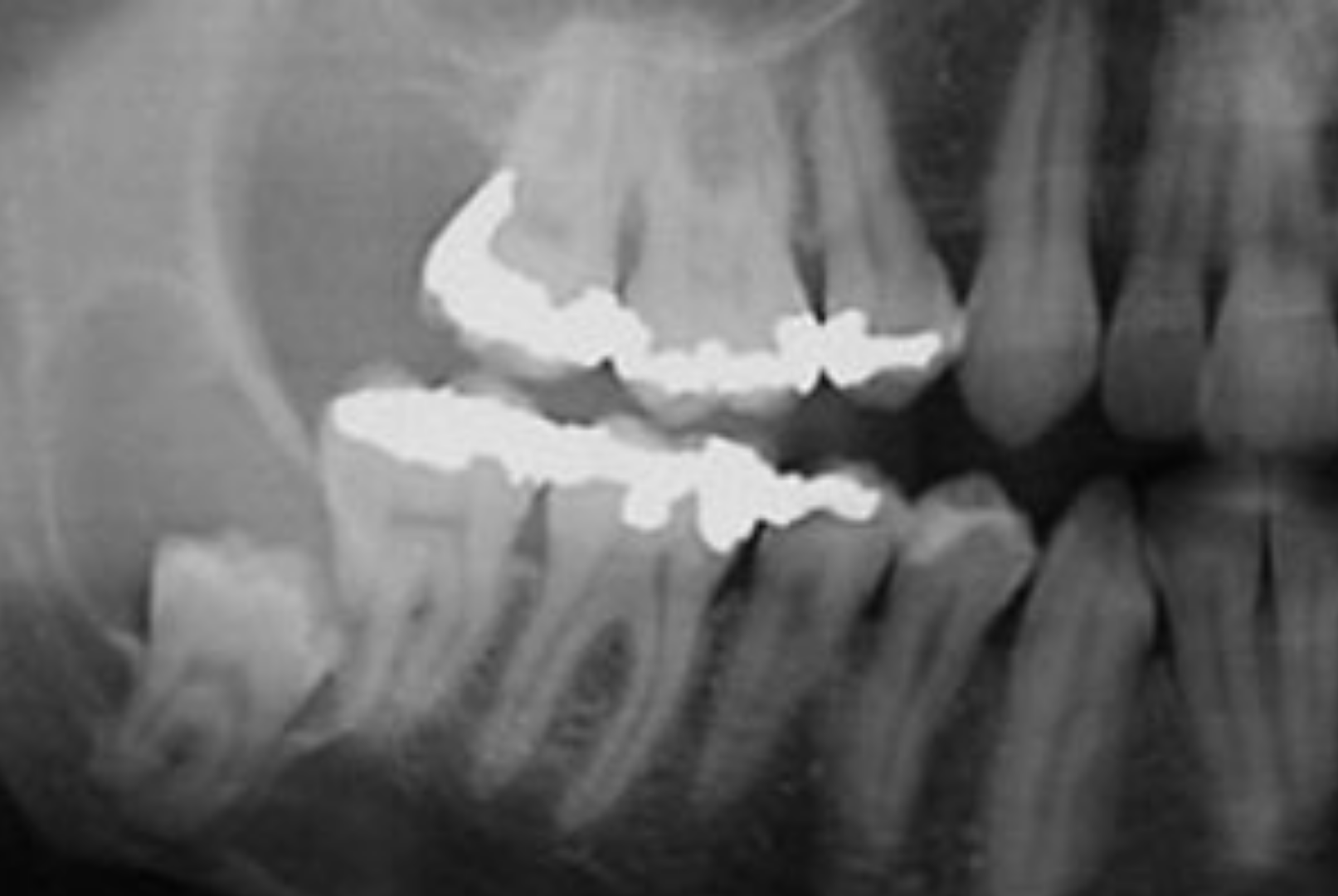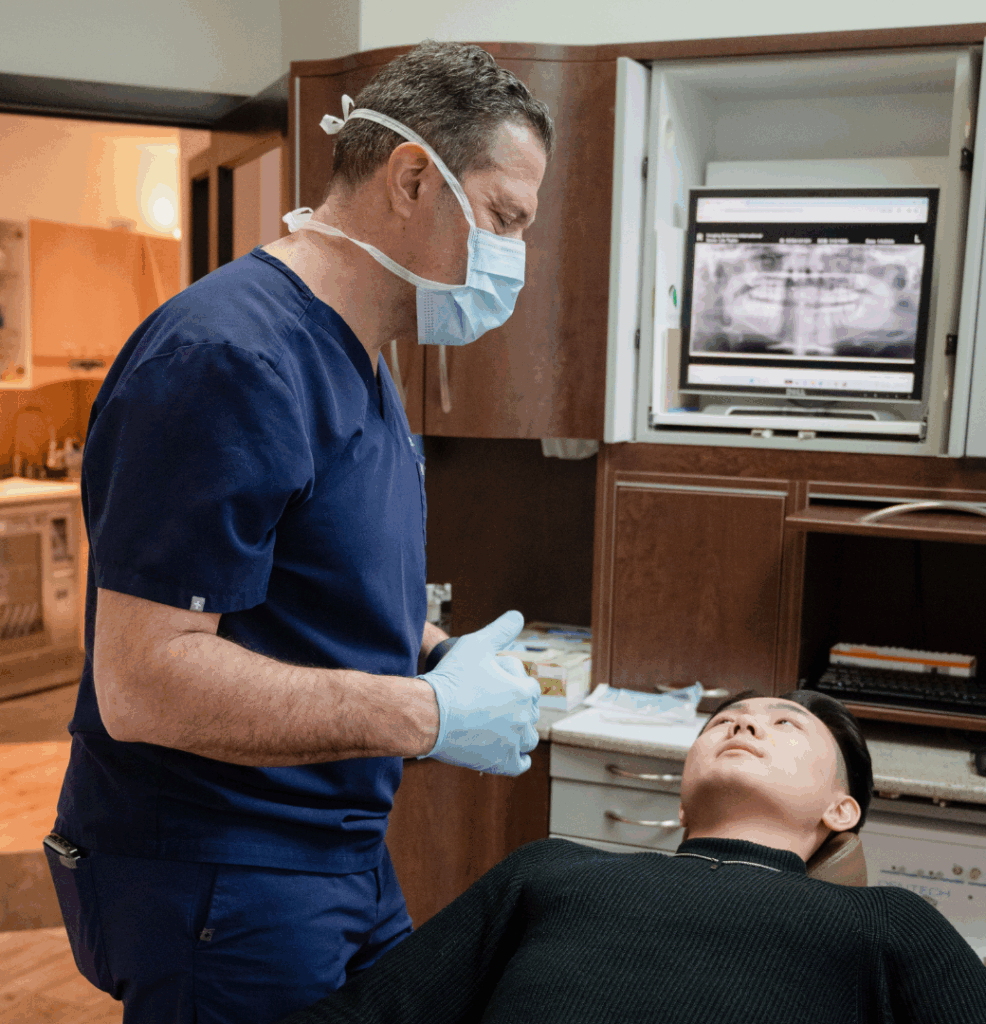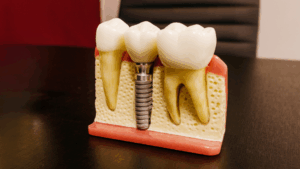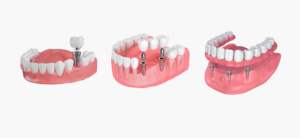Wisdom teeth, also known as third molars, typically develop between the ages of 17 and 25. Although they are a natural part of the dental arch, they often lead to issues that require professional evaluation. According to some estimates, up to 70% of young adults in Quebec will eventually need to consider having their wisdom teeth removed.
However, it’s important to note that extraction is not always necessary. In some cases, wisdom teeth erupt properly without causing symptoms or affecting oral health. In others, they can lead to pain, infections, or silent complications that should not be overlooked. Common reasons for extraction include lack of space in the jaw, risk of damage to adjacent teeth, or the presence of infection.
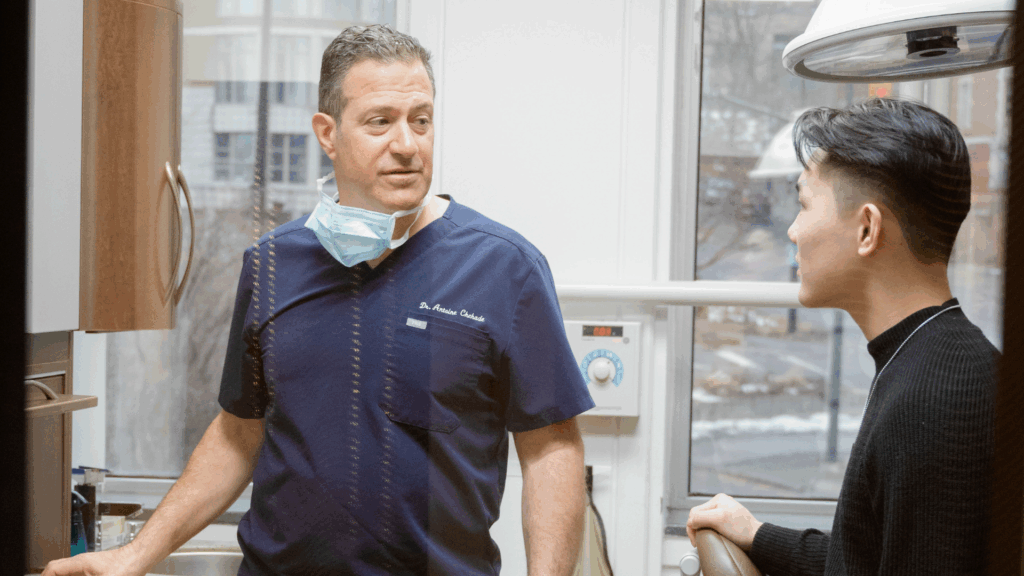
So, should wisdom teeth be extracted—and if so, at what age is it best to do so? Extraction is indicated in specific cases, particularly when symptoms or risk factors are identified by a dental professional. A variety of extraction techniques are available, tailored to the clinical condition of each patient. A significant number of complications can occur if extraction is delayed, such as infections or damage to nearby teeth. In many cases, postponing the procedure results in more complex surgery and a longer recovery time.
Here’s an overview of the key signs you shouldn’t ignore and the clinical factors that may or may not support the need for extraction.

Pain or Discomfort: Common Warning Signs
The first sign of a problem related to wisdom teeth is often a dull ache or a feeling of discomfort at the back of the jaw.
Common symptoms include:
- Swollen gums that are tender to the touch or appear reddish
- Intermittent pain, sometimes triggered by chewing
- Jaw stiffness, especially in the morning or at the end of the day
- Difficulty fully opening the mouth
- Pain that radiates to the ear, face, or head
These symptoms often occur when a wisdom tooth is trying to erupt but lacks the necessary space. This can put pressure on neighbouring teeth, leading to malocclusion or ongoing discomfort.
As soon as these signs appear, it’s important to schedule a visit to a dental clinic to determine whether the wisdom teeth need to be removed.
Infections and Pericoronitis: A Common Complication
Among young adults, infections related to partially erupted wisdom teeth are common—especially pericoronitis. This condition refers to an inflammation of the gum tissue that partially covers a wisdom tooth. An infection may also lead to bleeding or interfere with blood clot formation, which can complicate healing.
Why is this type of infection so common?
- A partially erupted tooth leaves an opening between the gum and the tooth.
- This area becomes prone to the accumulation of bacteria, food debris, and plaque.
- Oral hygiene is difficult to maintain in this region, making infection almost inevitable without professional intervention.
Signs of pericoronitis:
- Sharp, localized pain
- Significant swelling of the gum tissue behind the molars
- Bad taste in the mouth
- Mild fever or general fatigue
- Limited ability to fully open the mouth
If left untreated, pericoronitis can develop into a more serious infection that spreads to the jaw, cheeks, or even the neck. In such cases, the removal of the affected wisdom teeth is usually recommended.
Impacted or Misaligned Teeth: Structural Concerns
Some wisdom teeth fail to erupt and remain impacted in the jawbone or gum tissue. They are located at the very back of the mouth, in the deepest part of the jaw.
Risks associated with misaligned or impacted teeth:
- Premature wear or cavities on adjacent teeth
- Root damage to the second molars
- Development of cysts or abscesses
Often, these complications are silent but can lead to irreversible damage to the integrity of the dentition and jawbone.
A radiographic examination (panoramic or 3D) is essential to detect these issues. If impacted wisdom teeth present a short- or medium-term risk, their removal is strongly recommended.
Cysts, Root Damage, and Other Hidden Threats
Even in the absence of pain, some wisdom teeth can pose significant clinical risks. In certain cases, extracting wisdom teeth is the only way to prevent serious complications. The reason a preventive extraction may be recommended—even without symptoms—is to avoid future problems that could be more difficult to treat.
Common silent complications include:
- Resorption of the roots of adjacent teeth
- Interference with the maxillary sinuses (especially for upper wisdom teeth)
- Cavities that are difficult to detect without imaging
- Development of follicular cysts that can destroy the surrounding bone
These conditions are often identified during routine visits to the dental clinic. The absence of pain does not necessarily mean there’s no problem. That’s why regular radiographic monitoring is essential—especially if the wisdom teeth have not yet erupted.
Should All Wisdom Teeth Be Removed? The Role of Targeted Monitoring
Contrary to popular belief, not all wisdom teeth need to be extracted. In certain situations, a conservative approach based on clinical and radiographic monitoring is preferred. If they are not causing symptoms or complications, wisdom teeth can be kept under observation.
Situations where preventive extraction may be avoided:
- The wisdom teeth are erupting normally, without obstruction or pain.
- There are no associated symptoms—no inflammation or infection.
- The teeth are functional, properly aligned, and accessible for adequate oral hygiene.
- Imaging shows no damage to adjacent structures

In such cases, dentists usually recommend regular follow-ups, typically every 12 to 24 months, involving:
- Panoramic x-rays to monitor root development or detect early cyst formation
- Assessment of available space in the jaw
- Examination of the peri-coronal gum tissue to detect early signs of pericoronitis
This approach helps delay or even avoid extraction, as long as the situation remains stable. It is particularly appropriate for asymptomatic patients whose wisdom teeth are fully erupted, well-positioned, and healthy.
It is therefore essential to tailor the treatment strategy to each individual clinical case, rather than automatically opting for invasive dental surgery.
Ideal Age for Wisdom Tooth Evaluation and Extraction
The ideal time to have wisdom teeth evaluated is usually between the ages of 16 and 19. At this stage:
- The roots are not yet fully developed, and the stage of root formation affects how easy the extraction will be.
- The jawbone is more flexible, which makes removal easier.
- The risk of post-operative complications is lower.
- Healing tends to be faster.
That said, even in adults, wisdom teeth can be successfully removed with proper planning.
The question of optimal timing for extraction should be discussed with a dentist, as every patient has unique anatomical and health considerations.
Surgical Procedure Details and Postoperative Care
When wisdom teeth extraction is indicated, it is performed under sterile conditions in a dental clinic or, in some cases, in a hospital setting. Several types of procedures may be considered depending on the complexity of the case, ranging from a simple extraction to more advanced surgical interventions. The type of procedure depends on various factors, including the position of the tooth, the degree of impaction, nerve proximity, and the patient’s overall health.
Surgical Options:
- Local anesthesia: used for simple extractions when the teeth are fully erupted and accessible.
- Conscious sedation (oral or intravenous): recommended for anxious patients or when multiple extractions are required.
- General anesthesia: reserved for more complex procedures, especially in cases involving deeply impacted teeth or cysts.
A complete radiographic assessment is always performed beforehand to properly plan the surgery and reduce the risk of complications, such as nerve damage or bone trauma.
Postoperative recovery:
How long does recovery take after wisdom tooth extraction?
In general, recovery lasts 7 to 10 days, depending on the complexity of the procedure and the patient’s healing capacity.
To ensure optimal recovery, it’s important to follow specific care instructions:
- Apply ice during the first 48 hours to reduce swelling.
- Take all prescribed pain relievers and anti-inflammatory medications.
- Eat a soft, lukewarm, and non-irritating diet—especially important in the first few days.
- Practice gentle oral hygiene, avoiding brushing the surgical site early on.
- Monitor for signs of infection, such as fever, increasing pain, or pus-like discharge.
It’s also recommended to avoid intense physical activity during recovery to avoid complications and support proper healing.
In certain cases, radiographic follow-up may be required to confirm bone healing—especially after complex surgeries or when complications are expected.
Conclusion
Wisdom teeth can either be completely harmless or a source of significant oral health issues, depending on their position, development, and the symptoms they cause. While they don’t always need to be removed, it’s essential to have them evaluated by an experienced dental professional.
The decision to extract should be based on a careful assessment of individual risk factors and overall oral health. If symptoms are present—or if there is any doubt—it’s strongly recommended to book a consultation to help prevent long-term complications and maintain oral wellness.
Wisdom teeth, also known as third molars, typically develop between the ages of 17 and 25. Although they are a natural part of the dental arch, they often lead to issues that require professional evaluation. According to some estimates, up to 70% of young adults in Quebec will eventually need to consider having their wisdom teeth removed.
However, it’s important to note that extraction is not always necessary. In some cases, wisdom teeth erupt properly without causing symptoms or affecting oral health. In others, they can lead to pain, infections, or silent complications that should not be overlooked. Common reasons for extraction include lack of space in the jaw, risk of damage to adjacent teeth, or the presence of infection.

So, should wisdom teeth be extracted—and if so, at what age is it best to do so? Extraction is indicated in specific cases, particularly when symptoms or risk factors are identified by a dental professional. A variety of extraction techniques are available, tailored to the clinical condition of each patient. A significant number of complications can occur if extraction is delayed, such as infections or damage to nearby teeth. In many cases, postponing the procedure results in more complex surgery and a longer recovery time.
Here’s an overview of the key signs you shouldn’t ignore and the clinical factors that may or may not support the need for extraction.

Pain or Discomfort: Common Warning Signs
The first sign of a problem related to wisdom teeth is often a dull ache or a feeling of discomfort at the back of the jaw.
Common symptoms include:
- Swollen gums that are tender to the touch or appear reddish
- Intermittent pain, sometimes triggered by chewing
- Jaw stiffness, especially in the morning or at the end of the day
- Difficulty fully opening the mouth
- Pain that radiates to the ear, face, or head
These symptoms often occur when a wisdom tooth is trying to erupt but lacks the necessary space. This can put pressure on neighbouring teeth, leading to malocclusion or ongoing discomfort.
As soon as these signs appear, it’s important to schedule a visit to a dental clinic to determine whether the wisdom teeth need to be removed.
Infections and Pericoronitis: A Common Complication
Among young adults, infections related to partially erupted wisdom teeth are common—especially pericoronitis. This condition refers to an inflammation of the gum tissue that partially covers a wisdom tooth. An infection may also lead to bleeding or interfere with blood clot formation, which can complicate healing.
Why is this type of infection so common?
- A partially erupted tooth leaves an opening between the gum and the tooth.
- This area becomes prone to the accumulation of bacteria, food debris, and plaque.
- Oral hygiene is difficult to maintain in this region, making infection almost inevitable without professional intervention.
Signs of pericoronitis:
- Sharp, localized pain
- Significant swelling of the gum tissue behind the molars
- Bad taste in the mouth
- Mild fever or general fatigue
- Limited ability to fully open the mouth
If left untreated, pericoronitis can develop into a more serious infection that spreads to the jaw, cheeks, or even the neck. In such cases, the removal of the affected wisdom teeth is usually recommended.
Impacted or Misaligned Teeth: Structural Concerns
Some wisdom teeth fail to erupt and remain impacted in the jawbone or gum tissue. They are located at the very back of the mouth, in the deepest part of the jaw.
Risks associated with misaligned or impacted teeth:
- Premature wear or cavities on adjacent teeth
- Root damage to the second molars
- Development of cysts or abscesses
Often, these complications are silent but can lead to irreversible damage to the integrity of the dentition and jawbone.
A radiographic examination (panoramic or 3D) is essential to detect these issues. If impacted wisdom teeth present a short- or medium-term risk, their removal is strongly recommended.
Cysts, Root Damage, and Other Hidden Threats
Even in the absence of pain, some wisdom teeth can pose significant clinical risks. In certain cases, extracting wisdom teeth is the only way to prevent serious complications. The reason a preventive extraction may be recommended—even without symptoms—is to avoid future problems that could be more difficult to treat.
Common silent complications include:
- Resorption of the roots of adjacent teeth
- Interference with the maxillary sinuses (especially for upper wisdom teeth)
- Cavities that are difficult to detect without imaging
- Development of follicular cysts that can destroy the surrounding bone
These conditions are often identified during routine visits to the dental clinic. The absence of pain does not necessarily mean there’s no problem. That’s why regular radiographic monitoring is essential—especially if the wisdom teeth have not yet erupted.
Should All Wisdom Teeth Be Removed? The Role of Targeted Monitoring
Contrary to popular belief, not all wisdom teeth need to be extracted. In certain situations, a conservative approach based on clinical and radiographic monitoring is preferred. If they are not causing symptoms or complications, wisdom teeth can be kept under observation.
Situations where preventive extraction may be avoided:
- The wisdom teeth are erupting normally, without obstruction or pain.
- There are no associated symptoms—no inflammation or infection.
- The teeth are functional, properly aligned, and accessible for adequate oral hygiene.
- Imaging shows no damage to adjacent structures

In such cases, dentists usually recommend regular follow-ups, typically every 12 to 24 months, involving:
- Panoramic x-rays to monitor root development or detect early cyst formation
- Assessment of available space in the jaw
- Examination of the peri-coronal gum tissue to detect early signs of pericoronitis
This approach helps delay or even avoid extraction, as long as the situation remains stable. It is particularly appropriate for asymptomatic patients whose wisdom teeth are fully erupted, well-positioned, and healthy.
It is therefore essential to tailor the treatment strategy to each individual clinical case, rather than automatically opting for invasive dental surgery.
Ideal Age for Wisdom Tooth Evaluation and Extraction
The ideal time to have wisdom teeth evaluated is usually between the ages of 16 and 19. At this stage:
- The roots are not yet fully developed, and the stage of root formation affects how easy the extraction will be.
- The jawbone is more flexible, which makes removal easier.
- The risk of post-operative complications is lower.
- Healing tends to be faster.
That said, even in adults, wisdom teeth can be successfully removed with proper planning.
The question of optimal timing for extraction should be discussed with a dentist, as every patient has unique anatomical and health considerations.
Surgical Procedure Details and Postoperative Care
When wisdom teeth extraction is indicated, it is performed under sterile conditions in a dental clinic or, in some cases, in a hospital setting. Several types of procedures may be considered depending on the complexity of the case, ranging from a simple extraction to more advanced surgical interventions. The type of procedure depends on various factors, including the position of the tooth, the degree of impaction, nerve proximity, and the patient’s overall health.
Surgical Options:
- Local anesthesia: used for simple extractions when the teeth are fully erupted and accessible.
- Conscious sedation (oral or intravenous): recommended for anxious patients or when multiple extractions are required.
- General anesthesia: reserved for more complex procedures, especially in cases involving deeply impacted teeth or cysts.
A complete radiographic assessment is always performed beforehand to properly plan the surgery and reduce the risk of complications, such as nerve damage or bone trauma.
Postoperative recovery:
How long does recovery take after wisdom tooth extraction?
In general, recovery lasts 7 to 10 days, depending on the complexity of the procedure and the patient’s healing capacity.
To ensure optimal recovery, it’s important to follow specific care instructions:
- Apply ice during the first 48 hours to reduce swelling.
- Take all prescribed pain relievers and anti-inflammatory medications.
- Eat a soft, lukewarm, and non-irritating diet—especially important in the first few days.
- Practice gentle oral hygiene, avoiding brushing the surgical site early on.
- Monitor for signs of infection, such as fever, increasing pain, or pus-like discharge.
It’s also recommended to avoid intense physical activity during recovery to avoid complications and support proper healing.
In certain cases, radiographic follow-up may be required to confirm bone healing—especially after complex surgeries or when complications are expected.
Conclusion
Wisdom teeth can either be completely harmless or a source of significant oral health issues, depending on their position, development, and the symptoms they cause. While they don’t always need to be removed, it’s essential to have them evaluated by an experienced dental professional.
The decision to extract should be based on a careful assessment of individual risk factors and overall oral health. If symptoms are present—or if there is any doubt—it’s strongly recommended to book a consultation to help prevent long-term complications and maintain oral wellness.


